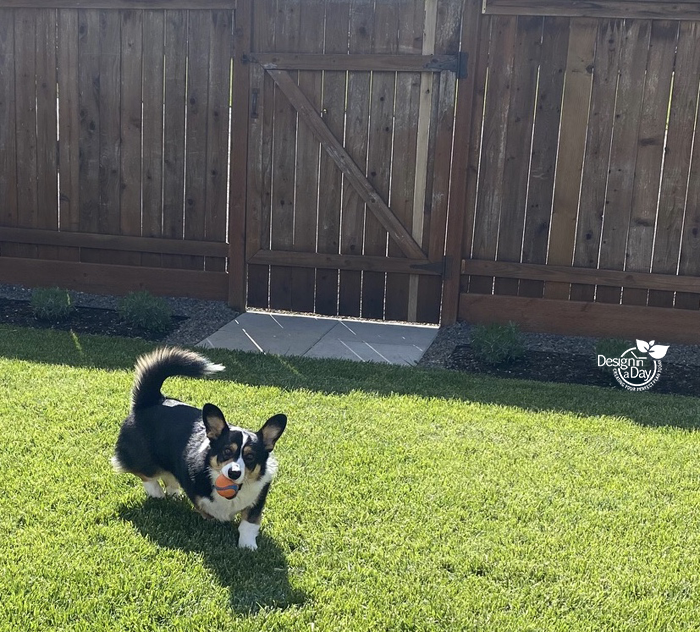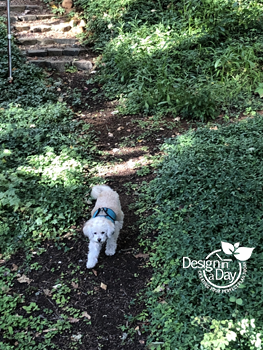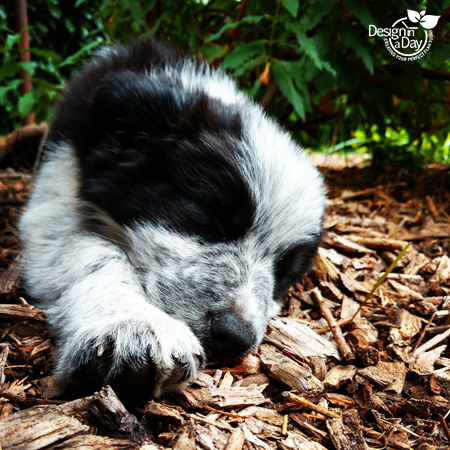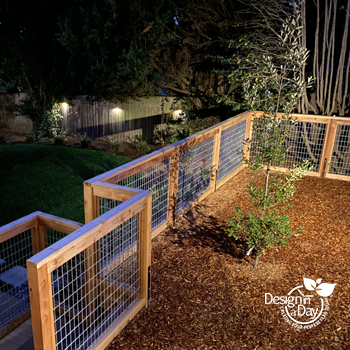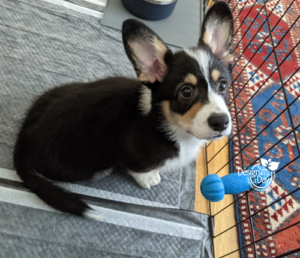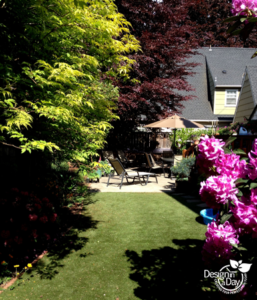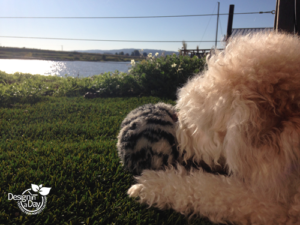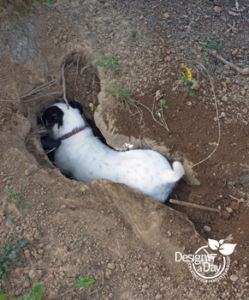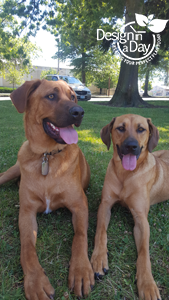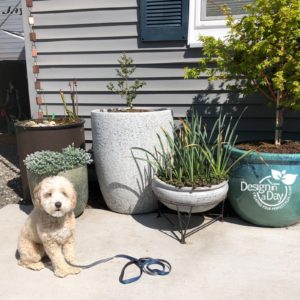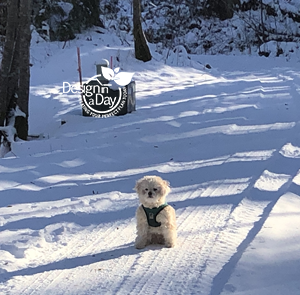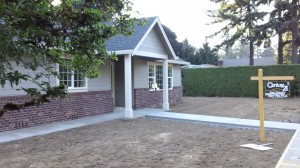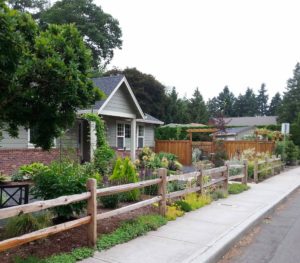Dog friendly Back Yards in North Portland
Here at Landscape Design in a Day we create a lot of dog friendly landscapes for our Portland clients. Today I’ll share my experience (pro and con) with 5 typical surfaces for dog friendly backyards. And I’ll have an excuse for cramming in lots of cute dog photos into the blog.
One of Alana’s designs featured 3 areas for the family dog. One was for dry feet in the winter and so designed to be mud free. One area is for summer and a dog cannot reach it during wet weather. The third area is for the dog only when its people are present. Most of our clients don’t have enough yard for this solution but the following materials for the surfaces were at the heart of this design.
Materials for dog friendly landscapes
I’ll start with our least favorite surface – Bark Dust
I don’t like to use bark dust for the primary area for my dog or a clients’ dog. Fleas, splinters, some of it tracks in and yet when I was a kid we had lawn and lots of bark dust and our dog never seemed to have a problem with it. Maybe that is because she had so much lawn. So I don’t use bark dust for the primary dog area.
Bark Dust
Bark dust harbors fleas and may need to be treated with chemicals to get rid of them. Cedar chips don’t. Cedar chips are not much more expensive than bark dust and it lasts longer. We never used to allow cedar chips to mulch plantings, people believed it would remove nitrogen from the soils. New research indicates this old idea is not true and I’m so delighted because having both cedar chips and bark dust in the same yard ends up looking very messy, bark dust migrating into the chips and vice versa.
Cedar Chips
This is my favorite for a dog area and I am also using it as a plant mulch when I don’t want my clients to have to install edging. There is a specific kind of cedar chip that I like to use. The easiest one to buy is at Mt Scott Fuel in SE Portland. It is called NW Play Fiber and it doesn’t seem to splinter, it lays nicely together and makes a thick cover and it lasts for years. Fir chips and other non cedar wood chips don’t last.
I like to lay the chips 6″ deep. The only negative I have noticed is with active large dogs in small spaces. Running and wrestling with their buddy dogs can displace some chips up against a fence. The chips hold some moisture and now you have moisture up against the wood fence panels.
One client had an Irish setter who liked to run down the middle of her yard and then bounce up against the fence. My clients have to rake the chips off the fence. They don’t mind because overall the chips have been such a blessing and are so much better than the muddy half grass they had. Fir chips are not cheaper and will have to be topped up every year where cedar chips will last several years. Arborist chips are too large and are awkward for dogs to run on and for people to walk on. They have an important place as a way to improve your soil and bring in good mycorrhizae (beneficial bacteria) but are not a product I recommend for a dog area. They are just too lumpy.
Synthetic Lawn Pro and Con – Dog Friendly Back Yard
Pro Yes! Synthetic lawn can be a great solution for dog owners with shady back yards or small yards. Anyone who wants to get away from wasting water, mowing and fertilizing may be attracted to synthetic lawn. My clients with dogs and shady back yards love their synthetic lawn. With synthetic lawn there is no muddy winter lawn and it’s easy to clean up those dog treasures year round.
Con Synthetic Lawn will it smell like dog pee? yes it could especially if you have multiple dogs.
Some people hose the spots their pets tend to visit, others actually run their irrigation system to rinse the urine odor out. Apparently people use a chemical on their synthetic lawn to keep them from smelling. Using a chemical doesn’t seem to be going in the right direction.
Is Synthetic Lawn harmful to trees?
Con – I have had an arborist warn me to place synthetic lawn away from existing trees. I was given this formula. For every inch of tree (diameter at breast height) place the synthetic lawn out another foot. This is not practical for small city properties with large trees. I would suggest consulting an ISA certified arborist to advise about whether there is a way to mitigate problems for trees where the synthetic lawn would be close to the trunk. Synthetic lawn as a surface over our soil that alters the living microorganisms in the soil. Is it worse for trees than a concrete patio? Concrete is a non natural surface. Another arborist pointed out that many installation companies use a heavy application of herbicide as part of their preparation for the synthetic lawn installation. I would want to be sure that if a herbicide is used, it is applied by a professional who knows when and how to apply it to avoid harm to bees.
Is there ever a good reason to use an herbicide? Well…..maybe.
Pro Getting rid of the lawn will save all the water that would have been used to irrigate. This will prevent using any of the fertilizers or chemicals typically used to maintain a lawn and many of these are harmful to bees. Does this offset a one time use of professionally applied herbicide? Each of us has to decide the answer to these questions. I know of a large company who wanted to have a real Willamette Valley meadow installed on several acres specially for pollinators. They decided to use herbicide to kill off the old lawn by first cutting the lawn down to an inch tall so there would be no flowers for bees to be attracted to. Then they used the herbicide. The meadow is now in its first spring and will be safely feeding thousands upon thousands of pollinators as it matures.
The New Tall Type Fescue versus old fashion short fescue blends
For yards with more sun, a newer type of grass, tall type fescue (one brand name is RTF) handles dog traffic, urine and poo better than traditional grass. A contractor friend (with Autumn Leaf Landscape) has noticed the RTF lawn in his own backyard has fared much better than his old fescue blend lawn with his two large dogs. Another benefit with RTF is that when you get a bare spot in the lawn, it can fill in faster because of its spreading (rhizomatic) root system. Traditional lawn roots clump and do not spread quickly and so the old fescue blends needed more re-seeding because they clumped slowly.
Dogs who are Talented at Destruction will make a mess of your lawn no matter what kind you have.
RTF fills in quicker than traditional grass, which means less areas for dirt to become mud in the winter. But most anyone would have the new lawn area fenced off until it was well established before turning the dog(s) loose upon it. If you have large dogs, and a small patch of grass even RTF isn’t going to cut it. And some dogs who are (TAD) talented at destruction, regardless of their size will need the lawn very very well established before having access. A professional lawn installer who used to install for dog parks told me he fenced off a new lawn area for 2 full years before it was open to dogs.
Of course, this solution depends on your type of dog, and how “fantastic” they are at tearing up your back yard. For some dogs, especially multi dog families, no real lawn is going to hold up to their needs so using grass means there will be worn paths into the grass. You need a lot of grass to manage multiple dogs and lots of sun. Shade, lawn and dogs means winter mud.
Size of dogs obviously matters here. Smaller dogs can wear a path into a lawn but they don’t pee in a large volume. A large dog, after being in the house all day, could drop a quart 5 seconds after he or she is released into the yard.

My neighbor Rudy happily lives on a Portland house boat and takes a lot of walks, sometimes with me. Proof some dogs don’t need a traditional lawn and yard.
City Dogs with Small Yards Need the Local Park to Save the Lawn
Small dogs and older dogs are often quite happy with lounging around on concrete or flagstone with their humans. Many city people take their dogs for walks and to parks daily and this relieves the stress on your outdoor living areas of multiple daily doses of dog urine. Most of these clients don’t want a special area for a dog potty because they simply do not have the room.
I never use these materials for dog friendly landscape surfaces
I do not recommend round rock, also called pea gravel. It can end up trapped inside a dogs foot pad. It’s hard on their ankles and same is true for humans. People can slip because the round rock is not stable, it rolls and so can you. Pea gravel is very appealing to the eye. Don’t do it and if you have some, get rid of it. It’s not a good surface for anyone.
I’m not fond of loose crushed rock but perhaps if you check your dogs pads frequently it might be fine for you. It’s not what I would want for sharing a space with my dog but a non compacted crushed rock is becoming more popular because of how well it works with rainwater. An un-compacted crushed rock surface is fully water permeable and compacted crushed rock is not. I have plenty of clients with gravel patios whose dogs have not had issues with gravel or any gravel up in the dogs foot pads. I had it happen once with my cocker spaniel but we caught it in time and it did not get infected. Oddly he did not limp even though the gravel was up high inside his paw. Don’t make the only surface for your dog crushed rock.
Concrete is terrible for dogs backs and knees and smells bad with repeated doses of urine.
Balance – hard and soft surfaces for your dog
Ideally we are looking for hardscape for patios and areas for furniture and frequent human use with soft surfaces for dogs to play and walk on. It’s a matter of balance. Many clients want a concrete or stone patio but also have paths topped with soft materials like mulch or cedar chips. Crushed rock is more affordable and non compacted crushed rock allows rain water to penetrate into the soil. You have some concrete areas or some crushed rock areas but you also have other surfaces for them to romp and run on it may be fine for you.
Contact Us
We love to work with the whole family when we design a Portland back yard. Contact us for creative solutions that allow the whole family to enjoy the back yard including your 4 legged family members.

